warning light Abarth 500 2016 Owner handbook (in English)
[x] Cancel search | Manufacturer: ABARTH, Model Year: 2016, Model line: 500, Model: Abarth 500 2016Pages: 215, PDF Size: 19.08 MB
Page 130 of 215

CONDITIONS OF USE
Cold starting
Short journeys and frequent cold starts
do not allow the engine to reach
optimum operating temperature. This
results in a significant increase in
consumption levels (from +15 to +30%
on the urban cycle) and emissions.
Traffic and road
conditions
High fuel consumption is caused by
heavy traffic, for instance when
travelling in a queue with frequent use
of low gears or in cities with many traffic
lights. Winding mountain roads and
rough road surfaces also adversely
affect consumption.
Stops in traffic
During prolonged hold-ups (e.g. level
crossings) switch off the engine.TOWING TRAILERS
IMPORTANT
INFORMATION
For towing caravans or trailers the car
must be fitted with a certified tow hook
and an adequate electrical system.
Installation should be carried out by
specialised personnel who will issue the
required papers for travelling on roads.
Install any specific and/or additional
door mirrors as specified by the
Highway Code.
Remember that when towing a trailer,
steep hills are harder to climb, braking
distances increase and overtaking
takes longer depending on the overall
weight of the trailer.
Engage a low gear when driving
downhill, rather than constantly using
the brake.
The weight the trailer exerts on the car
tow hook reduces the car's loading
capacity by the same amount. To make
sure that the maximum towable weight
is not exceeded (given in the car
registration document) account should
be taken of the fully laden trailer,
including accessories and luggage.Respect the speed limits specific to
each country for vehicles towing
trailers.
In any case, the top speed must not
exceed 100 km/h.
101) 102)
WARNING
101) The ABS with which the car is
equipped will not control the
braking system of the trailer.
Particular caution is therefore
required on slippery surfaces.
102) Never modify the braking
system of the car to control the
trailer brake. The trailer braking
system must be fully independent
of the carŌĆÖs hydraulic system.
126
STARTING AND DRIVING
Page 134 of 215
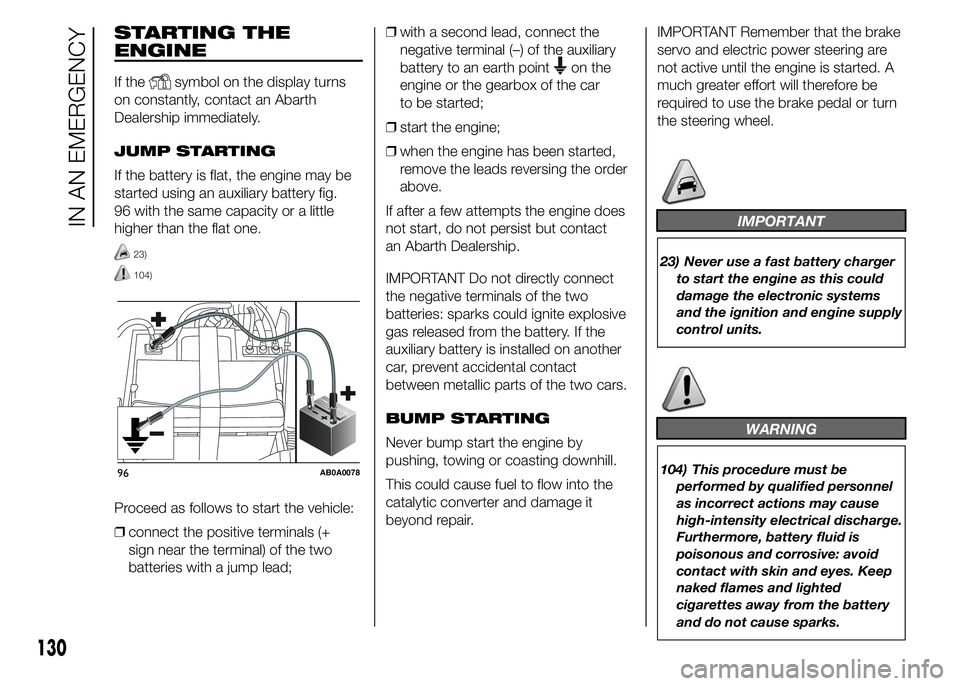
STARTING THE
ENGINE
If thesymbol on the display turns
on constantly, contact an Abarth
Dealership immediately.
JUMP STARTING
If the battery is flat, the engine may be
started using an auxiliary battery fig.
96 with the same capacity or a little
higher than the flat one.
23)
104)
Proceed as follows to start the vehicle:
ŌØÆconnect the positive terminals (+
sign near the terminal) of the two
batteries with a jump lead;ŌØÆwith a second lead, connect the
negative terminal (ŌĆō) of the auxiliary
battery to an earth point
on the
engine or the gearbox of the car
to be started;
ŌØÆstart the engine;
ŌØÆwhen the engine has been started,
remove the leads reversing the order
above.
If after a few attempts the engine does
not start, do not persist but contact
an Abarth Dealership.
IMPORTANT Do not directly connect
the negative terminals of the two
batteries: sparks could ignite explosive
gas released from the battery. If the
auxiliary battery is installed on another
car, prevent accidental contact
between metallic parts of the two cars.
BUMP STARTING
Never bump start the engine by
pushing, towing or coasting downhill.
This could cause fuel to flow into the
catalytic converter and damage it
beyond repair.IMPORTANT Remember that the brake
servo and electric power steering are
not active until the engine is started. A
much greater effort will therefore be
required to use the brake pedal or turn
the steering wheel.
IMPORTANT
23) Never use a fast battery charger
to start the engine as this could
damage the electronic systems
and the ignition and engine supply
control units.
WARNING
104) This procedure must be
performed by qualified personnel
as incorrect actions may cause
high-intensity electrical discharge.
Furthermore, battery fluid is
poisonous and corrosive: avoid
contact with skin and eyes. Keep
naked flames and lighted
cigarettes away from the battery
and do not cause sparks.96AB0A0078
130
IN AN EMERGENCY
Page 137 of 215
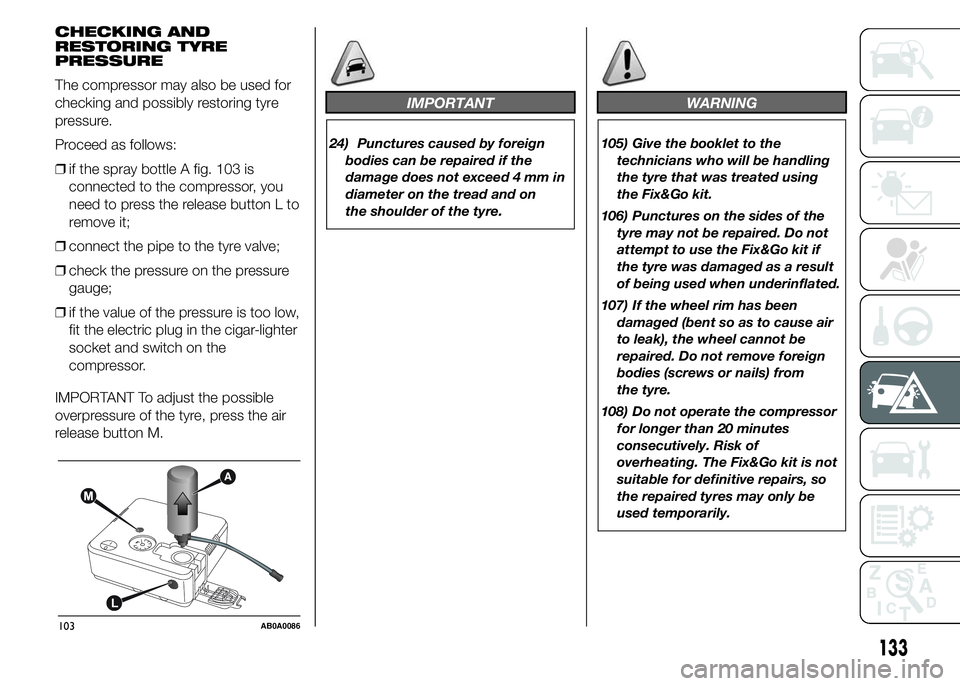
CHECKING AND
RESTORING TYRE
PRESSURE
The compressor may also be used for
checking and possibly restoring tyre
pressure.
Proceed as follows:
ŌØÆif the spray bottle A fig. 103 is
connected to the compressor, you
need to press the release button L to
remove it;
ŌØÆconnect the pipe to the tyre valve;
ŌØÆcheck the pressure on the pressure
gauge;
ŌØÆif the value of the pressure is too low,
fit the electric plug in the cigar-lighter
socket and switch on the
compressor.
IMPORTANT To adjust the possible
overpressure of the tyre, press the air
release button M.
IMPORTANT
24) Punctures caused by foreign
bodies can be repaired if the
damage does not exceed 4 mm in
diameter on the tread and on
the shoulder of the tyre
.
WARNING
105) Give the booklet to the
technicians who will be handling
the tyre that was treated using
the Fix&Go kit.
106) Punctures on the sides of the
tyre may not be repaired. Do not
attempt to use the Fix&Go kit if
the tyre was damaged as a result
of being used when underinflated.
107) If the wheel rim has been
damaged (bent so as to cause air
to leak), the wheel cannot be
repaired. Do not remove foreign
bodies (screws or nails) from
the tyre.
108) Do not operate the compressor
for longer than 20 minutes
consecutively. Risk of
overheating. The Fix&Go kit is not
suitable for definitive repairs, so
the repaired tyres may only be
used temporarily.
103AB0A0086
133
Page 142 of 215

WARNING
114) Changes or repairs to the electrical system carried out incorrectly and without due consideration for the technical
specifications of the system may lead to malfunctioning and generate a fire hazard.
115) Halogen bulbs contain pressurised gas. If they break, glass fragments could fly everywhere.
IMPORTANT
25) Halogen bulbs must be handled by holding the metallic part only. Touching the transparent part of the bulb with
your fingers may reduce the intensity of the emitted light and even reduce the lifespan of the bulb. In the event of
accidental contact, wipe the bulb with a cloth moistened with alcohol and let the bulb dry.
26) Where possible, it is advisable to have bulbs changed at an Abarth Dealership. The correct operation and alignment
of the external lights are absolutely essential for the safety of the car and of compliance with the law.
138
IN AN EMERGENCY
Page 146 of 215

NUMBER PLATE LIGHTS
To replace the bulbs proceed as
follows:
ŌØÆapply pressure to the point shown by
the arrow fig. 115 and remove the
lens;
ŌØÆchange the bulb, releasing it from the
side contacts;
ŌØÆfit the new bulb and make sure that it
is correctly clamped between the
contacts;
ŌØÆthen refit the lens.
WARNING
116) Due to the high power supply
voltage, gas discharge bulbs
(Xenon) should only be replaced
by specialised personnel: danger
of death! Contact an Abarth
Dealership.
REPLACING AN
INTERIOR BULB
For the type of bulb and power rating,
see paragraph "Replacing a bulb".
INTERIOR ROOF LIGHT
To replace the bulb, proceed as follows:
ŌØÆusing the screwdriver provided,
extract the roof light A fig. 116
working in the point shown by the
arrow;
115AB0A0099
116AB0A0100
142
IN AN EMERGENCY
Page 151 of 215
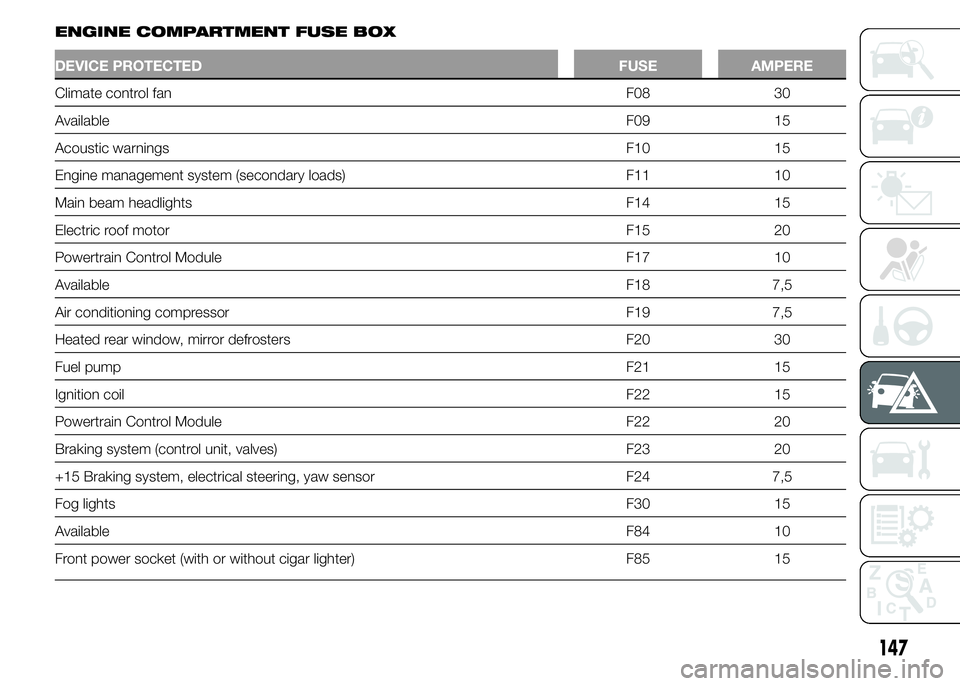
ENGINE COMPARTMENT FUSE BOX
DEVICE PROTECTED FUSE AMPERE
Climate control fan F08 30
AvailableF09 15
Acoustic warnings F10 15
Engine management system (secondary loads) F11 10
Main beam headlights F14 15
Electric roof motor F15 20
Powertrain Control Module F17 10
AvailableF18 7,5
Air conditioning compressor F19 7,5
Heated rear window, mirror defrosters F20 30
Fuel pumpF21 15
Ignition coilF22 15
Powertrain Control Module F22 20
Braking system (control unit, valves) F23 20
+15 Braking system, electrical steering, yaw sensor F24 7,5
Fog lightsF30 15
AvailableF84 10
Front power socket (with or without cigar lighter) F85 15
147
Page 159 of 215
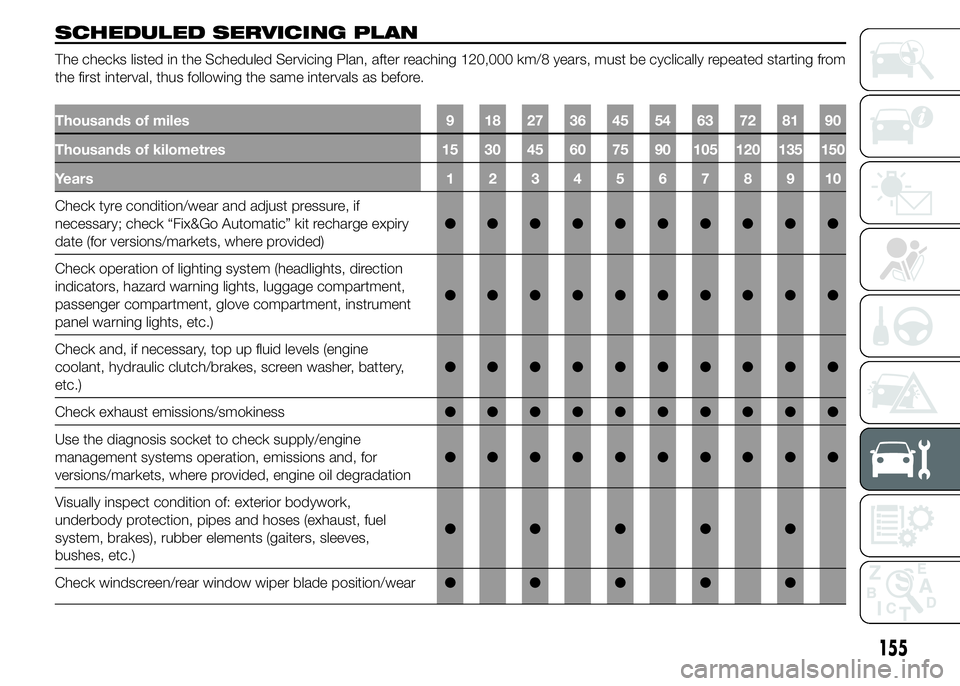
SCHEDULED SERVICING PLAN
The checks listed in the Scheduled Servicing Plan, after reaching 120,000 km/8 years, must be cyclically repeated starting from
the first interval, thus following the same intervals as before.
Thousands of miles 9 18 27 36 45 54 63 72 81 90
Thousands of kilometres 15 30 45 60 75 90 105 120 135 150
Years12345678910
Check tyre condition/wear and adjust pressure, if
necessary; check ŌĆ£Fix&Go AutomaticŌĆØ kit recharge expiry
date (for versions/markets, where provided)ŌŚÅŌŚÅŌŚÅŌŚÅŌŚÅŌŚÅŌŚÅŌŚÅŌŚÅŌŚÅ
Check operation of lighting system (headlights, direction
indicators, hazard warning lights, luggage compartment,
passenger compartment, glove compartment, instrument
panel warning lights, etc.)ŌŚÅŌŚÅŌŚÅŌŚÅŌŚÅŌŚÅŌŚÅŌŚÅŌŚÅŌŚÅ
Check and, if necessary, top up fluid levels (engine
coolant, hydraulic clutch/brakes, screen washer, battery,
etc.)ŌŚÅŌŚÅŌŚÅŌŚÅŌŚÅŌŚÅŌŚÅŌŚÅŌŚÅŌŚÅ
Check exhaust emissions/smokinessŌŚÅŌŚÅŌŚÅŌŚÅŌŚÅŌŚÅŌŚÅŌŚÅŌŚÅŌŚÅ
Use the diagnosis socket to check supply/engine
management systems operation, emissions and, for
versions/markets, where provided, engine oil degradationŌŚÅŌŚÅŌŚÅŌŚÅŌŚÅŌŚÅŌŚÅŌŚÅŌŚÅŌŚÅ
Visually inspect condition of: exterior bodywork,
underbody protection, pipes and hoses (exhaust, fuel
system, brakes), rubber elements (gaiters, sleeves,
bushes, etc.)ŌŚÅŌŚÅŌŚÅŌŚÅŌŚÅ
Check windscreen/rear window wiper blade position/wearŌŚÅŌŚÅŌŚÅŌŚÅŌŚÅ
155
Page 162 of 215

PERIODIC CHECKS
Every 1,000 km or before long
journeys, check and, if necessary, top
up the following:
ŌØÆengine coolant level;
ŌØÆbrake fluid level;
ŌØÆwindscreen washer fluid level;
ŌØÆtyre inflation pressure and condition;
ŌØÆoperation of lighting system
(headlights, direction indicators,
hazard warning lights, etc.);
ŌØÆoperation of screen washer/wiper
system and positioning/wear of
windscreen/rear window wiper
blades.
Every 3,000 km check and, if
necessary, top up: engine oil level.
You are advised to use PETRONAS
LUBRICANTS products, which have
been designed and produced
specifically for Abarth cars (see table
"Capacities" in the "Technical
specifications" chapter).
HEAVY-DUTY USE OF
THE CAR
If the car is used mainly under one of
the following conditions:
ŌØÆtowing a trailer or caravan;
ŌØÆdusty roads;
ŌØÆshort, repeated journeys (less than
7-8 km) at sub-zero outside
temperatures;
ŌØÆengine often idling or driving long
distances at low speeds or long
periods of inactivity;
the following checks must be carried
out more often than indicated in the
Scheduled Servicing Plan:
ŌØÆcheck front disc brake pad condition
and wear;
ŌØÆcheck cleanliness of bonnet and
luggage compartment locks,
cleanliness and lubrication of linkage;
ŌØÆvisually inspect condition of: engine,
gearbox, transmission, pipes and
hoses (exhaust - fuel system -
brakes) and rubber elements (boots -
sleeves - bushes - etc.);
ŌØÆcheck battery charge and battery
fluid level (electrolyte);
ŌØÆvisually inspect condition of the
accessory drive belts;ŌØÆcheck and, if necessary, change
engine oil and replace oil filter;
ŌØÆcheck and, if necessary, replace
pollen filter;
ŌØÆcheck and, if necessary, replace air
cleaner.
158
SERVICING AND MAINTENANCE
Page 166 of 215
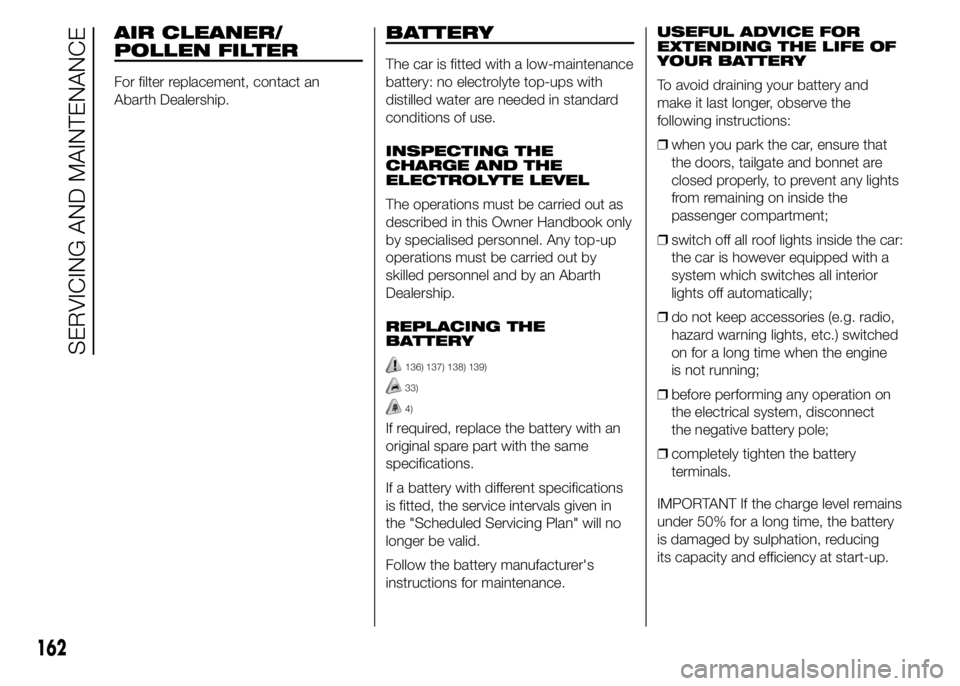
AIR CLEANER/
POLLEN FILTER
For filter replacement, contact an
Abarth Dealership.
BATTERY
The car is fitted with a low-maintenance
battery: no electrolyte top-ups with
distilled water are needed in standard
conditions of use.
INSPECTING THE
CHARGE AND THE
ELECTROLYTE LEVEL
The operations must be carried out as
described in this Owner Handbook only
by specialised personnel. Any top-up
operations must be carried out by
skilled personnel and by an Abarth
Dealership.
REPLACING THE
BATTERY
136) 137) 138) 139)
33)
4)
If required, replace the battery with an
original spare part with the same
specifications.
If a battery with different specifications
is fitted, the service intervals given in
the "Scheduled Servicing Plan" will no
longer be valid.
Follow the battery manufacturer's
instructions for maintenance.USEFUL ADVICE FOR
EXTENDING THE LIFE OF
YOUR BATTERY
To avoid draining your battery and
make it last longer, observe the
following instructions:
ŌØÆwhen you park the car, ensure that
the doors, tailgate and bonnet are
closed properly, to prevent any lights
from remaining on inside the
passenger compartment;
ŌØÆswitch off all roof lights inside the car:
the car is however equipped with a
system which switches all interior
lights off automatically;
ŌØÆdo not keep accessories (e.g. radio,
hazard warning lights, etc.) switched
on for a long time when the engine
is not running;
ŌØÆbefore performing any operation on
the electrical system, disconnect
the negative battery pole;
ŌØÆcompletely tighten the battery
terminals.
IMPORTANT If the charge level remains
under 50% for a long time, the battery
is damaged by sulphation, reducing
its capacity and efficiency at start-up.
162
SERVICING AND MAINTENANCE
Page 173 of 215

IMPORTANT
34) In order to preserve the aesthetic
appearance of the paint abrasive
products and/or polishes should
not be used for cleaning the car.
INTERIORS
Regularly check that water is not
trapped under the mats (due to water
dripping off shoes, umbrellas, etc.),
as this could cause oxidation of the
sheet metal.
145) 146)
SEATS AND FABRIC
PARTS
Remove dust with a soft brush or a
vacuum cleaner. It is advisable to use a
moist brush on velvet upholstery.
Rub the seats with a sponge moistened
with a solution of water and mild soap.
PLASTIC AND COATED
PARTS
It is advisable to clean interior plastic
parts with a moist cloth and a solution
of water and non-abrasive mild soap.
Use specific products for cleaning
plastic, without solvents and specifically
designed to prevent damage to the
appearance and colour of the treated
parts, to remove grease and tough
stains.
IMPORTANT Never use alcohol, petrols
and derivatives to clean the instrument
panel lens.LEATHER PARTS
(for versions/markets, where provided)
Use only water and mild soap to clean
these parts. Never use alcohol or
alcohol-based products. Before using a
specific product for cleaning interiors,
make sure that it does not contain
alcohol and/or alcohol-based
substances.
WARNING
145) Never use flammable products,
such as petroleum ether or
modified petrol, to clean the
inside of the car. The electrostatic
charges which are generated by
rubbing during cleaning may
cause a fire.
146) Do not keep aerosol cans in the
vehicle: these could explode.
Aerosol cans must not be exposed
to a temperature exceeding 50┬░C.
When the car is exposed to
sunlight, the internal temperature
can greatly exceed this value.
169